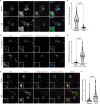This is a preprint.
An ANXA11 P93S variant dysregulates TDP-43 and causes corticobasal syndrome
- PMID: 37886540
- PMCID: PMC10602153
- DOI: 10.21203/rs.3.rs-3462973/v1
An ANXA11 P93S variant dysregulates TDP-43 and causes corticobasal syndrome
Update in
-
An ANXA11 P93S variant dysregulates TDP-43 and causes corticobasal syndrome.Alzheimers Dement. 2024 Aug;20(8):5220-5235. doi: 10.1002/alz.13915. Epub 2024 Jun 26. Alzheimers Dement. 2024. PMID: 38923692 Free PMC article.
Abstract
As genetic testing has become more accessible and affordable, variants of uncertain significance (VUS) are increasingly identified, and determining whether these variants play causal roles in disease is a major challenge. The known disease-associated Annexin A11 (ANXA11) mutations result in ANXA11 aggregation, alterations in lysosomal-RNA granule co-trafficking, and TDP-43 mis-localization and present as amyotrophic lateral sclerosis or frontotemporal dementia. We identified a novel VUS in ANXA11 (P93S) in a kindred with corticobasal syndrome and unique radiographic features that segregated with disease. We then queried neurodegenerative disorder clinic databases to identify the phenotypic spread of ANXA11 mutations. Multi-modal computational analysis of this variant was performed and the effect of this VUS on ANXA11 function and TDP-43 biology was characterized in iPSC-derived neurons. Single-cell sequencing and proteomic analysis of iPSC-derived neurons and microglia were used to determine the multiomic signature of this VUS. Mutations in ANXA11 were found in association with clinically diagnosed corticobasal syndrome, thereby establishing corticobasal syndrome as part of ANXA11 clinical spectrum. In iPSC-derived neurons expressing mutant ANXA11, we found decreased colocalization of lysosomes and decreased neuritic RNA as well as decreased nuclear TDP-43 and increased formation of cryptic exons compared to controls. Multiomic assessment of the P93S variant in iPSC-derived neurons and microglia indicates that the pathogenic omic signature in neurons is modest compared to microglia. Additionally, omic studies reveal that immune dysregulation and interferon signaling pathways in microglia are central to disease. Collectively, these findings identify a new pathogenic variant in ANXA11, expand the range of clinical syndromes caused by ANXA11 mutations, and implicate both neuronal and microglia dysfunction in ANXA11 pathophysiology. This work illustrates the potential for iPSC-derived cellular models to revolutionize the variant annotation process and provides a generalizable approach to determining causality of novel variants across genes.
Keywords: ANXA11; TDP-43; corticobasal syndrome; variant of uncertain significance.
Conflict of interest statement
Competing interests JSY serves on the scientific advisory board for the Epstein Family Alzheimer’s Research Collaboration. DSM is an advisor for Dyno Therapeutics, Octant, Jura Bio, Tectonic Therapeutic, and Genentech, and is a co-founder of Seismic Therapeutic. The authors AS, VHR, JH, SL, DMR, YAQ, KJ, XR, NLJ, AWK, MD, LVV, JNC, CT, BB, JYK, MRC, and MEW report no competing interests.
Figures






References
-
- Sainouchi M, Hatano Y, Tada M, et al. A novel splicing variant of ANXA11 in a patient with amyotrophic lateral sclerosis: histologic and biochemical features. Acta Neuropathol Commun. 2021;9(1). Accessed June 8, 2021. https://actaneurocomms.biomedcentral.com/articles/ - DOI - PMC - PubMed
Publication types
Grants and funding
- P50 AG023501/AG/NIA NIH HHS/United States
- 75N95022C00031/DA/NIDA NIH HHS/United States
- K01 AG049152/AG/NIA NIH HHS/United States
- R01 AG062588/AG/NIA NIH HHS/United States
- FI2 GM142475/GM/NIGMS NIH HHS/United States
- U54 NS123985/NS/NINDS NIH HHS/United States
- U19 AG079774/AG/NIA NIH HHS/United States
- P30 AG062422/AG/NIA NIH HHS/United States
- P01 AG019724/AG/NIA NIH HHS/United States
- R01 AG057234/AG/NIA NIH HHS/United States
- ZIA AG000534/ImNIH/Intramural NIH HHS/United States
- ZIA AG000539/ImNIH/Intramural NIH HHS/United States
- R00 AG068271/AG/NIA NIH HHS/United States
- K23 AG073514/AG/NIA NIH HHS/United States
LinkOut - more resources
Full Text Sources
Research Materials
Miscellaneous

